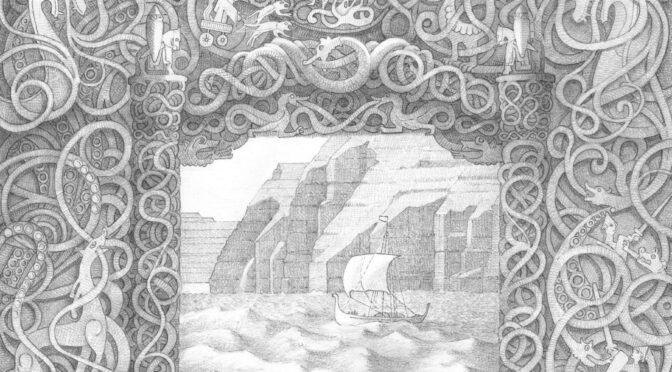(Red Hook, Brooklyn’s) population is a hopeless tangle and enigma; Syrian, Spanish, Italian, and negro elements impinging upon one another, and fragments of Scandinavian and American belts lying not far distant. It is a babel of sound and filth…legions of bleary-eyed, pockmarked youths still chant and curse and howl as they file from abyss to abyss, none knows whence or whither, pushed on by blind laws of biology which they may never understand.1
In this article, I’ll examine the outsized influence that “weird fantasy” author H.P. Lovecraft holds over Dungeons & Dragons (D&D), and how the nature of that influence has shifted. This will be viewed specifically through the lens of the “Deep Ones” and the “Kuo-Toa.” The former is one of Lovecraft’s earliest and most enduring creations, a cornerstone of the “Cthulhu Mythos.” The latter are Gary Gygax’s counterpart to them, first introduced in the 1978 adventure Dungeon Module D2: Shrine of the Kuo-Toa,2 and codified in the 1981 rulebook Fiend Folio: Tome of Creatures Malevolent and Benign. 3 I will review both fictional species within their original contexts, then examine the ways in which the kuo-toa evolved and diverged from their progenitors over the last forty years.
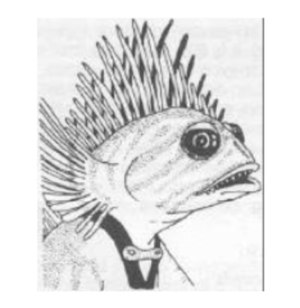
Both the Deep Ones and the kuo-toa are degenerate, violent “fish-men” who dwell in the grottos and oceans beneath the surface of the Earth. They worship incomprehensible alien deities and bitterly nurse their exile at the hands of a human race that no longer remembers them. Madness is their currency, as buyers and sellers. Although not iconic like orcs, dragons, elves, or rust monsters, the kuo-toa have been a steady presence in all five editions of D&D. Out of the thousands of creatures used in the game over its lifespan, they were for decades one of only eleven “Product Identity” creatures legally protected from open-source usage.4 Though the kuo-toa make for an unexpected bellwether, their development mirrors larger trends in the game itself. As they became more nuanced and sympathetic, so too did D&D seek a more inclusive approach for a more diverse fanbase; one which moved away from the racial determinism that characterized much of fantasy fiction, such as the kind exemplified in H.P. Lovecraft’s work.
The Cultists of Dagon: Racism and Fear of Miscegenation in Lovecraft’s Work
Grotesque beyond the imagination of a Poe or a Bulwer, they were damnably human in general outline despite webbed hands and feet, shockingly wide and flabby lips, glassy, bulging eyes, and other features less pleasant to recall…one of the creatures was shewn in the act of killing a whale represented as but little larger than himself. 5
Howard Phillips Lovecraft was born in 1890 in the coastal city of Providence, Rhode Island. A visionary writer largely unheralded in his lifetime, he created a rich and strange subgenre of sci-fi/horror that was starkly different from his 19th century gothic and romantic influences. In lieu of Manichean duality, moral certainty, and the omnipresence of a loving God, his stories depicted a vast, terrifying, and indifferent universe. There is no Satan in Lovecraft. The blind-idiot god Azathoth,6 the incomprehensible Old Ones, and the monstrous Mi-Go7 did not see humanity as a chosen people whose souls were to be won from God. The light of reason didn’t defeat the darkness; it illuminated something far worse. Lovecraft’s worldview was driven as much by his boundless creativity as it was by his own prejudices, neuroses, and fears. A fear of failure, the ocean, foreigners, African Americans, big cities, of everything unfamiliar and unknown.8 In his stories, as in his life, ignorance and isolation were preferable to the truth.

The first suggestion of the Deep Ones occurs in Lovecraft’s 1919 short story “Dagon,”9 whose title comes from an ancient Sumerian water deity. Although only his third published work, it would lay the foundation for the sprawling “Cthulhu Mythos” that would define his career and influence the coming century of literature. It’s a tale of a morphine-addicted man frantically recounting a time when his boat ran aground on a volcanic reef in the South Pacific. There he discovered an ancient, white monolith with carved images of fish-man monsters.
A massive creature emerges from the waves, “Vast, Polythemus-like, and loathsome.”10 The narrator experiences a bout of hysteria and is barely able to remember how he returned home. His mind and body rapidly decay thereafter. The story ends abruptly with the narrator writing of a hand scratching against his window, though the reality of this is ambiguous. A newspaper clipping in a later story of the Cthulhu Mythos alludes to a “a lone sleeper (leaping) from a window after a shocking cry.”11 It suggests a more definitive end for the narrator, if not the cause of it.
Lovecraft revisited and named the Deep Ones near the end of his career, in the spiritual sequel to “Dagon,” the 1936 novella The Shadow Over Innsmouth. The story follows protagonist Robert Olmstead and his investigation into a decaying Massachusetts coastal community with a dark history. Olmstead learns that generations earlier, a retired sea captain named Obed Marsh established a cult called The Esoteric Order of Dagon, which offered human sacrifices to the Deep Ones in exchange for wealth and plentiful fish. The cult also bred with the creatures, siring hybrid offspring that were born as humans, but acquired fish-like physical traits as they aged; the so-called “Innsmouth look.” These hybrids eventually transform into Deep Ones themselves, then migrate beneath the waves to the inhuman city of Y’ha-nthlei to live forever. An attempt by the US government to shut down the cult resulted in a violent retaliation against Innsmouth’s citizens, accelerating its decline.
The Innsmouth that Olmstead visits a century later is isolated and foreboding. It’s a dilapidated shadow of its former self, filled with hostile citizens bearing that “Innsmouth look.” Bad things happen to people who ask too many questions or provide too many answers, as in the case of an elderly citizen named Zadok Allen. He vanishes shortly after speaking to Olmstead. The protagonist soon attracts unwanted attention and is forced to flee town from an angry mob:
I could see them plainly only a block away—and was horrified by the bestial abnormality of their faces and the dog-like sub-humanness of their crouching gait. One man moved in a positively simian way, with long arms frequently touching the ground; while another figure—robed and tiaraed—seemed to progress in an almost hopping fashion. 12
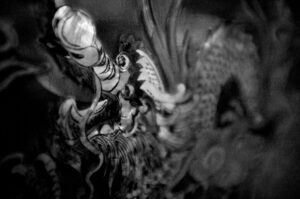
Through their infiltration of Innsmouth, and in the words of writer Caitlin R. Keirnan, their “devouring of (its) culture,”13 the Deep Ones are using the town as a beachhead to reconquer the surface world. Obed Marsh’s transgressions against the natural order have doomed all of humanity. They’ve certainly doomed the story’s narrator, whose own search for answers reveals a horrible truth. In the story’s conclusion, Olmstead’s discovers that Obed Marsh is his ancestor, and that his own bloodline is the result of Deep One interbreeding. He soon begins to acquire the “Innsmouth look,” and accepts that he’ll eventually be drawn down to Y’ha-nthlei.
Lovecraft biographer Leon Sprague De Camp connected the themes of The Shadow Over Innsmouth to Lovecraft’s well-documented racism, anti-Semitism, hatred of immigrants, and deep-seated fear of miscegenation.14 Lovecraft scholar T.J. Joshi and author Peter Straub admire the story, but describe it as a regression into more xenophobic territory after Lovecraft’s more complex aliens of At the Mountains of Madness.15 It’s possible that his failure to secure publication for At the Mountains of Madness, and the sting he felt at that late-career rejection, prompted a return to more familiar ideological stomping grounds.
Nonetheless, the Deep Ones have lingered in popular culture since their first appearance in pages of The Vagrant, over a century ago. Some of their many versions and derivations can be found in the works of August Derleth,16 Universal Pictures’ The Creature from the Black Lagoon, 17 George R.R. Martin’s A Song of Ice and Fire, 18 Alan Moore’s Providence,19 Guillermo del Toro’s The Shape of Water,20 and Gary Gygax and Dave Arneson’s Dungeons and Dragons.
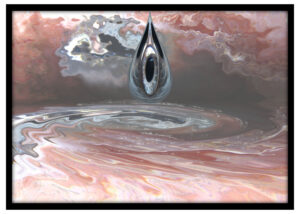
The Whips of Blipdoolpoolp: The Changing Vision of the Kuo-tao in D&D
The ancient Kuo-Toa People once inhabited the shores and islands the upper world, but as the race of mankind and its associate species grew more numerous and more powerful, the men-fish were slowly driven to remote regions…their inborn hatred of discipline prevent the resurgence of these creatures…insanity is not uncommon. 21
Gygax’s Shrine of the Kuo-Toa was bundled with the Descent into the Depths of the Earth adventure module, 22 which established the iconic “Underdark”; that wild and dangerous realm of tunnels and caverns that stretch for miles beneath the surface of the world. Its alien threats, bizarre vistas, and monstrous gods owe far more to Lovecraftian weirdness than to Tolkien-esque high fantasy. The kuo-toa are just one race among many in the Underdark’s ecosystem, and they are far down the hierarchy at that. Dark Elves, Mind Flayers, Beholders, Aboleths, and mid-level adventuring parties regularly subjugate and destroy them.
This is not to say that they are harmless. Madness, violence, and religious zealotry are the defining features of the kuo-toa species. The monk-like order of “Monitors” are charged with rooting out insanity whenever it blooms in the population, while the Priest-Kings and clerical caste of “Whips” rule in the name of their bizarre and profane goddess, “Blipdoolpoolp, The Sea Mother.” Gygax describes her shrine:
Upon the summit of the ziggurat stands a malachite statue 20′ tall. It appears to be a nude human female body, with articulated shell covering the shoulders and a lobster head and claws in place of the expected human head and arms. =23
Unlike almost all other sentient races in D&D, the kuo-toa do not worship a god of their own species. Blipdoolpoolp is a demanding and incomprehensible “other”; one with a strong visual link to the humans that oppressed them. This perversion of the “white savior” theme is a popular theme in “geek” media. 24 Fiction is replete with pre-industrial “savages” whose guilelessness and brutality allow them to be manipulated by charismatic, malicious outsiders: Colonel Kurtz and his Congolese worshippers, 25 Sauron’s elephant-riding “Swarthy Men”/”Easterlings,” 26 Randall Flagg’s flock in the epilogue of The Stand, 27 Rene Belloq in the opening moments of Raiders of the Lost Ark,28 and the “queer and evil-looking crew of Kanakas,”29 an archaic racial slur for Pacific Islanders used by the narrator of Lovecraft’s own The Call of Cthulhu.30
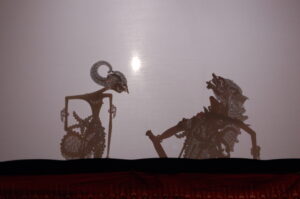
Blipdoolpoolp’s “other-ness” is compounded by her gender, a concept illuminated by scholar Barbara Creed’s notion of the “monstrous-feminine.”31 This trope applies to maternalistic figures of fiction and myth who have transgressed traditional bounds of power in patriarchal societies, and are presented as physically warped and corrupted. Macbeth‘s Weird Sisters, Lilith of the Dead Sea Scrolls, Baba Yaga of Russian myth, and the “vagina dentata” motif all align with this tradition. So too do contemporary creations like the Xenomorph queen of the Alien franchise and the Broodmother of the Dragon Age game series. 32 To the male-dominated theocracy of the kuo-toa, Blipdoolpoolp is not unlike the New Testament’s most famous “monstrous-feminine”: the “Whore of Babylon,” a mother to “abominations” that is “seated on many waters.” 33
The kuo-toa formally entered the D&D canon in 1981’s Fiend Folio. Almost all of the details were faithfully replicated from Dungeon Module D2: Shrine of the Kuo-Toa, but without the accompanying adventure. The Fiend Folio also replaced Jim Roslof’s original kuo-toa art from Dungeon Module D2: Shrine of the Kuo-Toa with new images by British artist Alan Hunter. The work has not aged well. Hunter’s kuo-toa are reimagined as pot-bellied primitives in loin cloths with massive lips, buffoonish eyes, dark scales, and fin spikes resembling “kinky” hair. 34 Whether intentional or a byproduct of the artist’s style, there are striking visual similarities between these kuo-toa and racist depictions of African American caricatures in traditional minstrel shows. Dr. David Pilgrim’s research for Ferris State University’s “Jim Crow Museum of Racist Memorabilia” identifies these traits and explores how they are used to dehumanize their subjects. Alternately portraying them as compliant and lazy, or savage brutes. 35
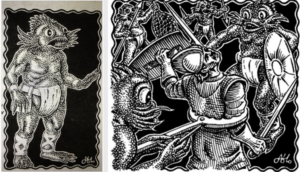
Hunter’s kuo-toa also bears something of a resemblance to the “Golliwog,” children’s doll that was ubiquitous in Britain in the first half of the 20th century, and would likely have been quite familiar to the artist. The “Golliwog” appealed to racist characterizations of African people as incapable of sophistication or critical thinking, relegating them to the realm of children and servants in a world of adults. 36 By the early 1980s the “Golliwog” had become controversial in Britain, 37 although there have been various attempts to “rehabilitate” the figure, it is deeply entangled with a history of colonialism, racism, and white supremacy.38
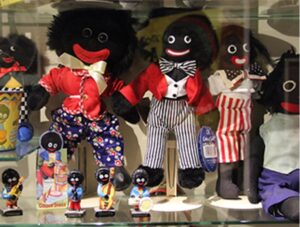
It is noteworthy that the 1995 Monstrous Manual of D&D’s second edition abandoned any hint of Hunter’s work. Instead, the art moves back towards Gygax and Roslof’s original conception of the kuo-toa as more beast than buffoon. In all other respects, the second edition still depicts them as savages, noting that their lack of discipline and racial madness is due to “possible inbreeding.” 39 Their nature was inherent and immutable, as much as that demonstrated by any scheming devil or mindless ooze. They were not the only ones.
The Shadow Over Sloopdilmonpolop: The Changing Face of the D&D Monster
A kuo-toa, (the monk) Shuushar is likely to be one of the more unusual creatures any of the adventurers have met. The aquatic hermit is a calm and peaceful presence. He is aware of his people’s well-deserved reputation for madness, and claims to have spent a lifetime in contemplation and solitary meditation to overcome that legacy. He appears to have been successful, exuding an aura of enlightened balance.40
In his 2017 article, “Privilege, Power, and Dungeons & Dragons: How Systems Shape Racial and Gender Identities in Tabletop Role-Playing Games, Mind, Culture, and Activity,” Antero Garcia notes that racial determinism has been baked into D&D from its earliest days. The earliest editions of D&D allowed (mostly white, male) human Player Characters (PCs) tremendous flexibility in behavior and class specialization, but it imposed restrictions on playable fantasy races. 41The ephemeral Elves favored magic, the forests, and free-spirited Arcadian societies. Dwarves wielded steel, mined the earth, and lived in regimented clan structures. Their enemies, the so-called “goblinoid races” like orcs, goblins, and bugbears, aspired mainly to tribal barbarism and endless war.
In 1997, TSR was acquired by Wizards of the Coast, creators of the widely successful Magic: The Gathering collectable card game.42 When Wizards of the Coast released the third edition of D&D in 2000, it was a more commercial product that was accessible to a broader audience. A comprehensive set of revised rules allowed players to rely less on arbitrary Dungeon Master (DM) “house rules,” and work instead with a more flexible system. The European-style medieval heroes that graced the covers of nearly all second edition “core books” 43 were replaced with neutral “tools of the trade” like swords, globes, and a dragon’s eye. 44 The previously White-European deities of the popular Forgotten Realms 45 game setting were represented instead by their church iconography, while their physical manifestations became abstract and mutable “avatars,” which were largely post racial. 46 In the character creation section of the Player’s Handbook, sample characters included a female Paladin and a dark-skinned, female Monk. 47 Throughout the entire game, the behavior of PCs, non-player characters (NPCs), and monsters were determined by their culture, experiences, and choices, rather than by their racial proclivities alone.
The kuo-toa are emblematic of this trend. In 2000, the 3rd edition Monster Manual changed the source of their madness as exposure to an alien consciousness in the Underdark, rather than an inherent racial flaw. 48 The 2003 sourcebook Underdark details the kuo-toan city of “Sloopdilmonpolop,” a neutral trading hub with a broad range of personalities and agendas. The city plays a vital role in the economy of the Underdark, providing complex interactions and new story opportunities for any adventuring parties. 49
Their most significant divergence from Lovecraftian racial determinism came in D&D’s fifth and most recent edition. The new Dungeons and Dragons Monster Manual recast the kuo-toa as mostly benign, low-tech, tribal creatures who were enslaved by the mind flayer empire. 50Subjected to generations of torture and magical experimentation, the survivors were left with a lost culture, broken minds, and latent psychic abilities. They were compelled to imagine new and strange gods for guidance, which their magically-empowered collective unconsciousness imbued with genuine power. As the Dungeons and Dragons Monster Manual explains:
(Blipdoolpoolp) was likely invented by a kuo-toa that improved on a broken human statue by adding the heads and limbs of a crustacean. In sudden awe of its handiwork, it then named the resulting form a god. 51
This revised Sea Mother who rules their theocracy is neither “creator” nor “outsider,” but something unique in the D&D universe. She is the kuo-toan trauma and rage—their rampaging id—made immediately manifest, and they are utterly in its thrall. It’s a creative flourish that provides tragedy and depth to the story of otherwise savage, slave-trading fish-men. It also makes them much more dangerous, as their delusion and madness can summon forth genuine threats.
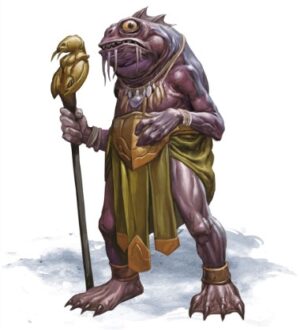
Conclusion: Fear From Within
In decoupling the kuo-toa from Lovecraft’s racist and xenophobic baggage, the designers of D&D’s fifth edition have expanded the creative possibilities and inclusiveness of the game. At its core, role-playing is an effort to better understand the self by seeing the world through new eyes. Humans are sophisticated, messy, contradictory, and multi-faceted creatures that, to quote Walt Whitman, “contain multitudes.” 52
The more layers of complexity imbued in a different perspective, the more likely it is that we can find a common point of connection. This underlying optimism of universality is central to the study of psychology and the humanities, as well as the concept of community itself.
Yet the presence of universal connection is as alien to the stories of H.P. Lovecraft as the blind idiot god Azathoth is to ours. Lovecraft would certainly argue that it is impossible to role-play a “Deep One”, a “Mi-Go”, or a “Great Old One.” The search for understanding would itself be dangerous, with any mortal mind risking madness and obliteration of the self. Lovecraft’s most famous work, “The Call of Cthuluhu,” opens with the narrator stating that: “The most merciful thing in the world, I think, is the inability of the human mind to correlate all its contents.”53 The sentence might be a wry self-reflection on the author’s own intellectual limitations, or it may be an ironic illustration his own obliviousness. It is beyond the scope of this paper to determine Lovecraft’s own level of personal awareness; if he understood the degree to which his prejudices may have influenced the terror and alienation displayed in his writing. What Lovecraft did understand, however, is that a journey into the world also involves a journey into the self. Whatever horrors exist within one’s self will be projected onto the darkness beyond.
–
Featured image “Dragon Boat” by Erik Berndt @Flickr CC – BY – XX – XX
–
Joshua Goldfond is a professional writer living in New York City. He has worked in advertising and journalism, and has written for film, TTRPG sourcebooks, graphic novels and literary fiction. His graduate thesis at NYU Steinhardt, The Digital Mask, contrasted TTRPGs and MMORPGs to study the role that online anonymity plays in self-representation and relationship building. He’s been playing role-playing games since the Great Old Ones were young. His website is https://www.joshuagoldfond.com.

